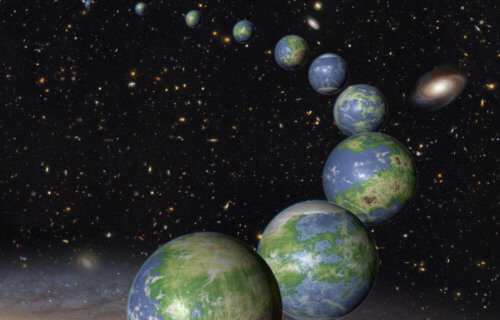LYON, France — There could be a hundred times the number of planets and moons with flowing water than previously thought, according to a new study. The findings mean space may be teeming with alien life that evolved in a similar way to life on Earth.
Earth-like alien worlds are dotted across the universe and many have the right geological conditions for underground oceans and lakes — when conditions on the surface are too cold. The findings increase the probability of discovering extraterrestrial water significantly. The results come from an analysis of small stars called M-dwarfs – the most common type which are much colder than our Sun.
“We know that the presence of liquid water is essential for life. Our work shows that this water can be found in places we had not much considered. This significantly increases the chances of finding environments where life could, in theory, develop,” says lead researcher Dr. Lujendra Ojha of Rutgers University in a media release.
The study found even if the surface of a planet is frozen there are two main ways that enough heat can be generated to allow water to liquify below.
“As Earthlings, we are lucky at the moment because we have just the right amount of greenhouse gases in our atmosphere to make liquid water stable on the surface,” Dr. Ojha continues.
“However, if Earth were to lose its greenhouse gases, the average global surface temperature would be approximately -18 degrees Celsius, and most surface liquid water would completely freeze. A few billion years ago, this actually happened on our planet and surface liquid water completely froze. However, this doesn’t mean that water was completely solid everywhere.”
“For example, heat from radioactivity deep in the Earth can warm water enough to keep it liquid. Even today, we see this happening in places like Antarctica and the Canadian Arctic, where despite the frigid temperature, there are large underground lakes of liquid water, sustained by the heat generated from radioactivity. There is even some evidence to suggest that this might be even happening currently in the south pole of Mars,” the lead researcher says.

The study is also a major discovery for alien hunters
The Milky Way alone has around 100 billion stars – each with at least one orbiting planet. Millions are in the “Goldilocks zone” where water is capable of existing as a liquid.
“Some of the moons you find in the solar system (for example, Europa or Enceladus) have substantial underground liquid water, even though their surfaces are completely frozen. This is because their interior is continually churned by the gravitational effects of the large planets they orbit, such as Saturn and Jupiter. This is similar to the effect of our Moon on tides, but much stronger. This makes the moons of Jupiter and Saturn prime candidates for finding life in our Solar System and many future missions have been planned to explore these bodies,” Dr. Ojha explains.
Roughly 70 percent of stars in our galaxy are M-dwarfs, and most rocky and Earth-like exoplanets found to date orbit them.
“We modelled the feasibility of generating and sustaining liquid water on exoplanets orbiting M-dwarfs by only considering the heat generated by the planet. We found that when one considers the possibility of liquid water generated by radioactivity, it is likely that a high percentage of these exoplanets can have sufficient heat to sustain liquid water– many more than we had thought,” Ojha reports.
“Before we started to consider this sub-surface water, it was estimated that around 1 rocky planet every 100 stars would have liquid water. The new model shows that if the conditions are right, this could approach 1 planet per star. So we are a hundred times more likely to find liquid water than we thought. There are around 100 billion stars in the Milky Way Galaxy. That represents really good odds for the origin of life elsewhere in the universe.”
The earliest mission to an icy moon will be NASA’s Europa Clipper, due to launch in 2024. It will arrive at Jupiter’s moon in 2030.
“The prospect of oceans hidden under ice sheets expands our galaxy’s potential for more habitable worlds. The major challenge is to devise ways to detect these habitats by future telescopes,” notes Professor Abel Méndez, Director of the Planetary Habitability Laboratory at the University of Puerto Rico at Arecibo.
Many worlds beyond the solar system could soon be within the grasp of our technology. More than 4,000 have been discovered so far. NASA satellite TESS is expected to multiply the number dramatically in the next decade.
Dr. Ojha presented the research at the Goldschmidt geochemistry conference in Lyon.
You might also be interested in:
- Life in an alien ocean? Astronomers discover one-of-a-kind ‘water world’
- A robot snake could help NASA scientists make contact with alien life
- Intelligent aliens are most likely living on planets with an Earth-like tilt
South West News Service writer Mark Waghorn contributed to this report.

